Maxus eDeliver 9 electric van review (2023)
Is the Maxus eDeliver 9 the secret answer to your large electric van needs?
PROS
- Swift and easy to drive
- Rides well
- Realistic range prediction
- Strong availability
- Decent choice of different body shapes and types
CONS
- Not the cheapest in the sector
- Lots of wind noise on the move
- Battery positioning reduces loadspace
- Some rough edges in the cabin
- Payload on bigger battery models not great
Summary
The Maxus name might be a familiar one to those with long memories of the UK van market, but this eDeliver 9 electric van is a long way from the old LDVs to bear the Maxus model name.
It’s a relatively new van, first released to comparatively little fanfare in 2020, and is now available in both diesel and this all-electric format.
It’s the electric model that is the most intriguing of the two, though, as it offers a real challenge to the existing big names and has a wide variety of options in terms of body sizes, batteries and models.
Range and payload
On the numbers alone, it can compete on two fronts, as it has either an impressive payload for an electric van or a strong range that can only be bettered by an elite few in the large van segment. You can’t have both range and payload together, though, but the fact that Maxus doesn’t choose one or the other on the buyer’s behalf is a real bonus.
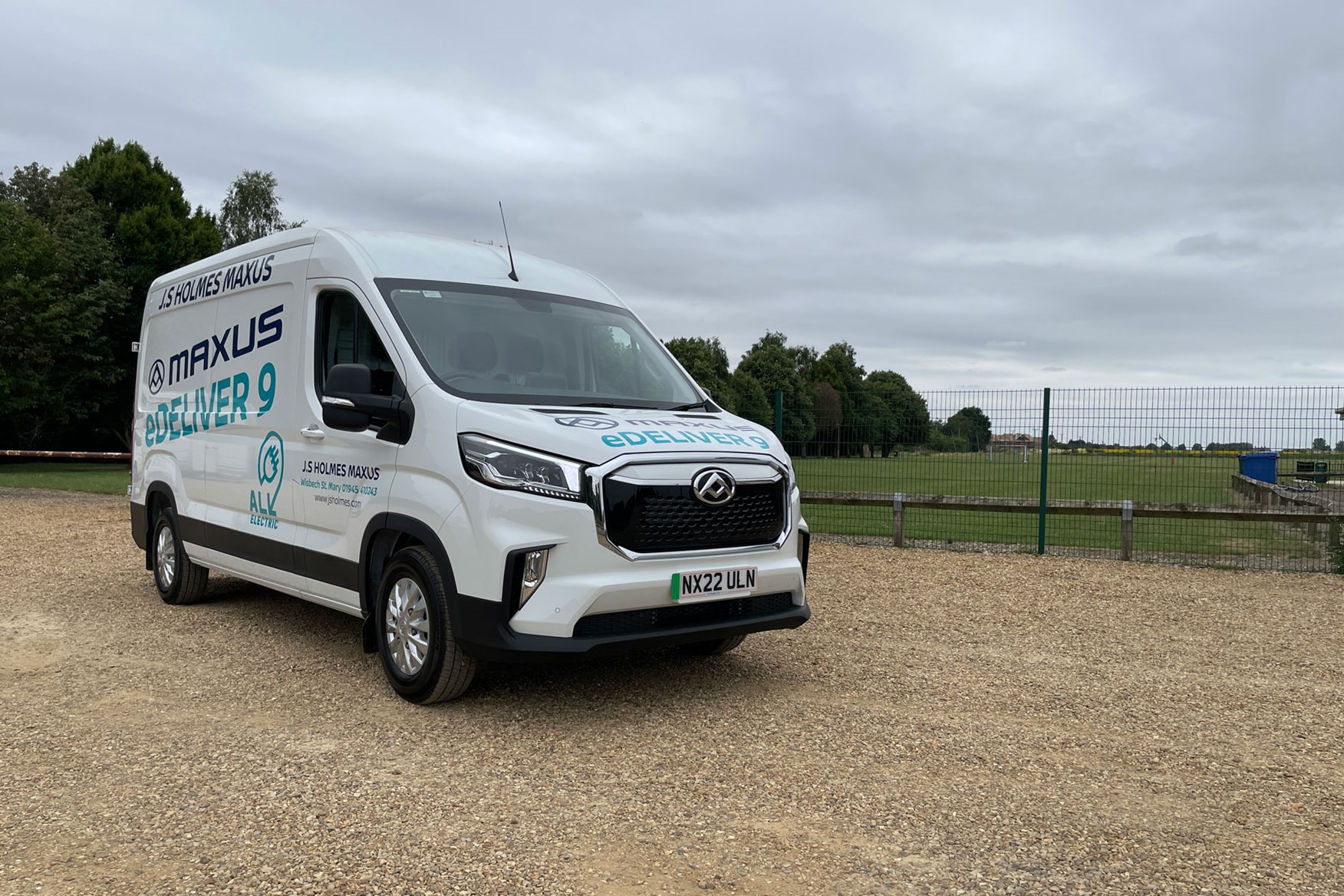
There are three batteries on offer, with the biggest being an 88.55kWh version that can go for 185 miles between charges. This is second only to the Ford E-Transit in terms of promised range, with many rivals offering significantly less.
The payload on that model might only be 860kg, but if you know you are sticking to short trips while carrying heavy loads then you can get a version with a 1,200kg payload.
It’ll charge quickly, too. DC charging will get it from 0-80% in just 40 minutes on some versions.
What are the Maxus eDeliver 9’s rivals?
The majority of van manufacturers now have an electric model in their large van range, although badge-sharing means that some are very similar to others.
The Citroen eRelay and Peugeot eBoxer are fundamentally the same van with different badges. They are not exactly representative of the future of electric motoring, though – they are outdated vans that have had a battery and a motor shoehorned in. The conversion is clear and they feel like stop-gap offers at best. We haven’t driven the Vauxhall Movano-e yet, but it is based on the same van so we expect it to be similar.
The same is true for the Renault Master E-Tech and the Fiat E-Ducato, although the latter does have the benefit of a huge payload in some versions to compensate slightly at least.
The Mercedes-Benz eSprinter doesn’t offer much of a range despite being created with electric in mind so like the rest of the group it lags far behind the runaway class leader, the Ford E-Transit.
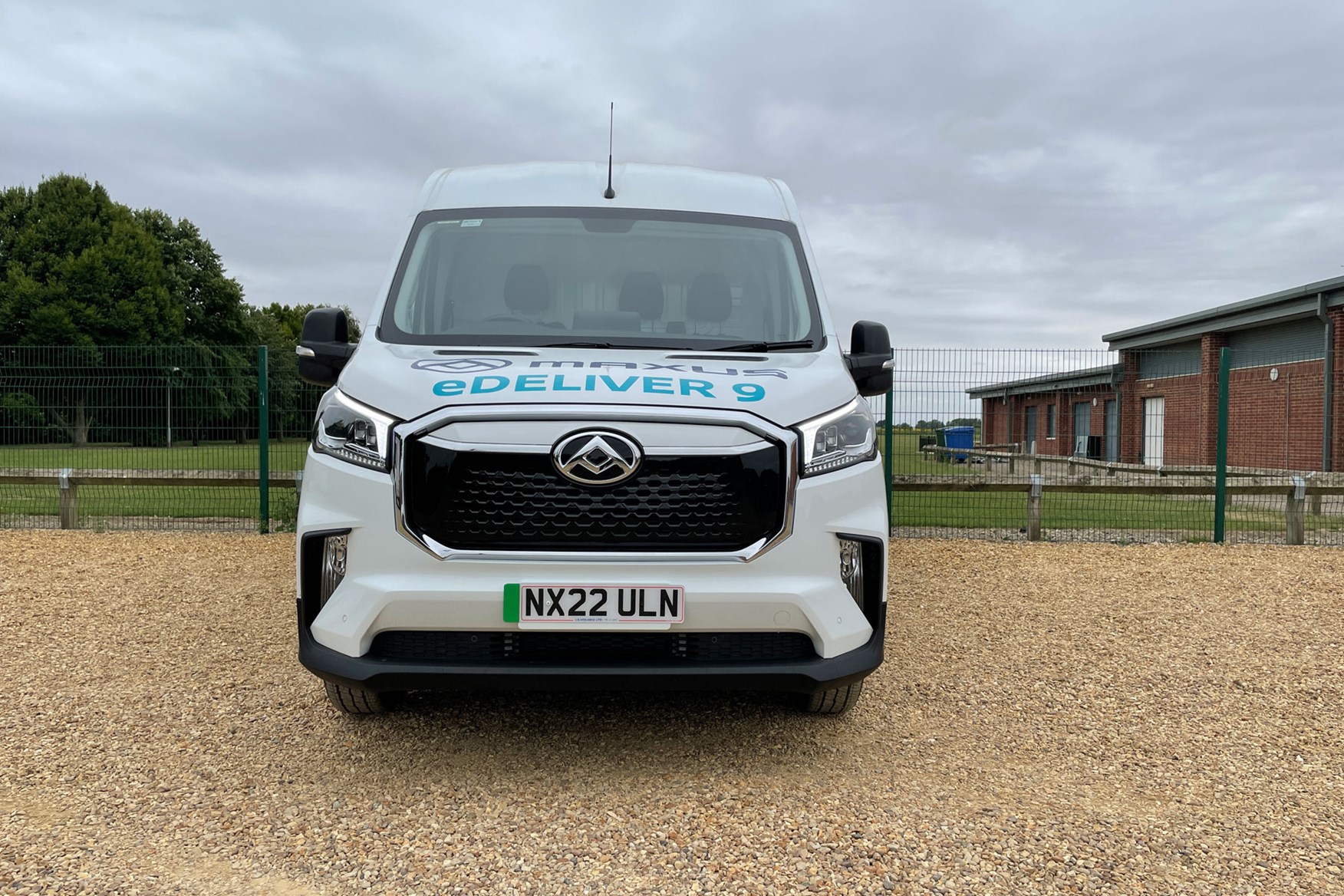
Verdict: is the Maxus eDeliver 9 any good?
Although nothing can match the peerless Ford E-Transit at the moment, the eDeliver 9 is arguably the next best on offer.
While many of the others feel like a poorly cobbled together semi solution, the Maxus does at least feel like it was designed to be an EV.
It might not come from a big-name brand like the E-Transit, but the level of support is only increasing, with Maxus adding retailers all the time. These retailers will likely be adding the brand alongside others, so they are at least likely to be familiar with commercial vehicles and / or EVs.
Skip to our full verdict on...
- Smooth and easy to drive
- Lots of instantaneous power
- Limited top speed
With all the oddities in the large electric van world, it is refreshing to see a cabin and a driving style that is unremarkable – you don’t have to do any sort of secret handshakes to get it started and get driving.
It’s keyless entry and start, so it is just a case of prodding a button and moving the conventional-looking gear lever into Drive and off you go.
What is the Maxus eDeliver 9 like to drive?
Regardless of which battery option you go for, you get the same motor. This is a punchy 150kW (201hp) motor, which gives you a brilliant and almost instantaneous surge of speed, from a standstill or on the move.
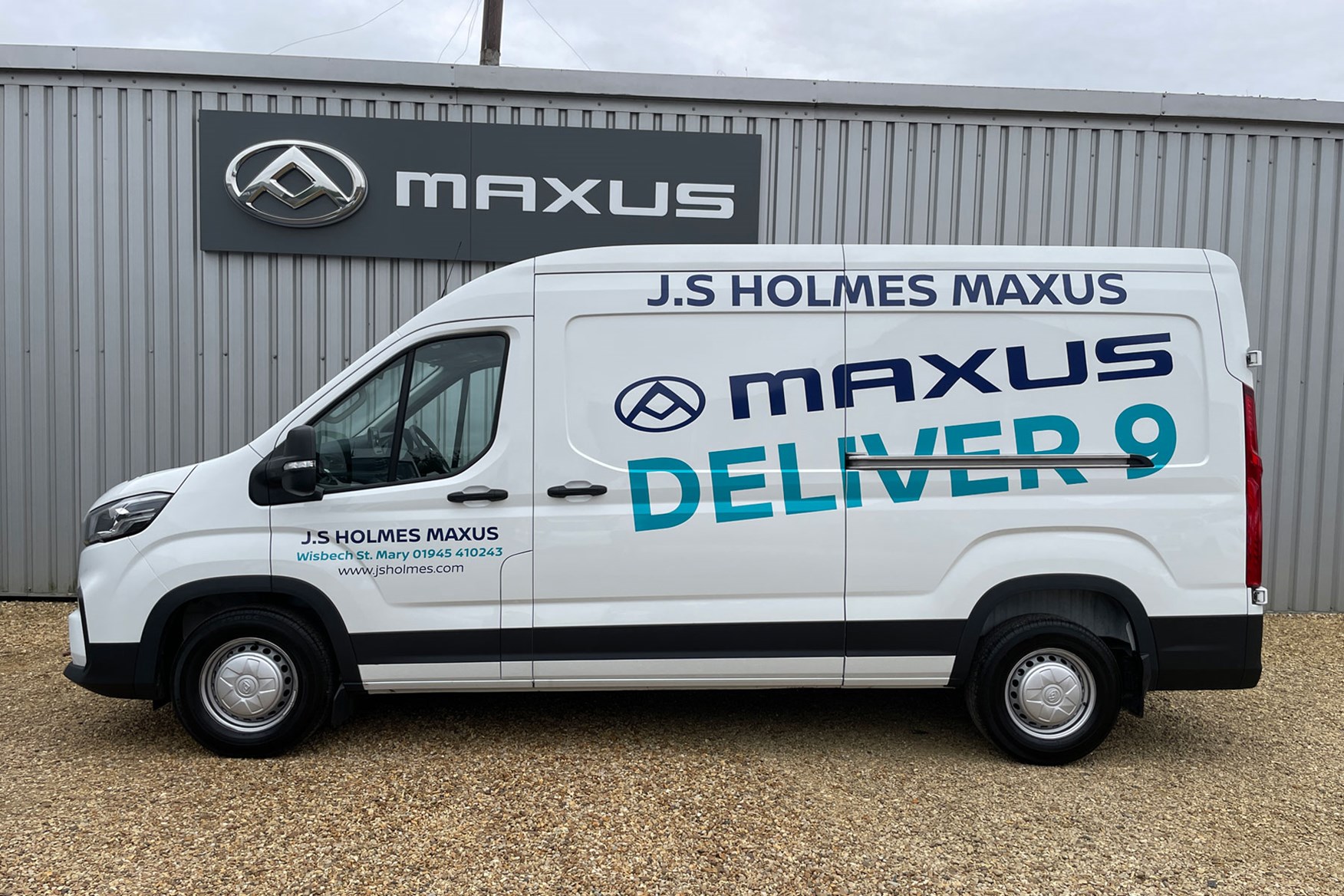
There are three driving modes, Eco, Normal and Power, but even Eco doesn’t dial back the power to the extent that you can’t prod the pedal to nip past something slow in town. Pop it into Power and there is a vast amount of pace, particularly when you are setting off from a standstill or a lower speed. While most vans dial back their power application or hold it back until you really push the pedal down to its full extremity, the eDeliver 9 gives you lots of it in a more progressive manner.
That is not to say that it is a go-kart-like hooligan, that will send the load in the back flying – the power comes steadily rather than all at once when you press the accelerator.
Moving between the three modes is one of the few oddities in the eDeliver 9. There are two buttons on the dash marked ‘Eco’ and ‘Power’. If you press it then it activates that mode and you deactivate it again to go back to normal – these things often come via a cycle and are operated using a single button. It is incredibly self-explanatory though.
There are three brake regeneration modes too. These are often operated by paddles behind the steering wheel and there are no such things in the Maxus. However, you use the gear lever – you move it to the right and go up and down through the modes in the same way as you might go through gears manually with an automatic transmission.
How does the Maxus eDeliver 9 ride and handle?
The ride is well controlled, and the low-down positioning of the batteries helps keep bodyroll from being too excessive.
In a bid to preserve battery, the speed is limited, officially to 62mph. Once it is at its top speed it is happy sitting there and it doesn’t feel strained on the motorway. Everything is generally fairly quiet, too – there are none of the odd bongs and whirrs that sometimes crop up on electric vans.
That said, there is a fair amount of wind noise when you get above about 40mph, particularly around the top of the driver’s door.
- Clean and simple cabin
- Not much storage versus rivals
- Slippery floor
While the Maxus eDeliver 3 has a cabin that can be best described as quirky, the eDeliver 9 takes a much simpler approach. The dashboard is a clean-looking design that looks modern and more car like than many of the vertical slab-like interiors of some of the older vehicles in the large-van sector.
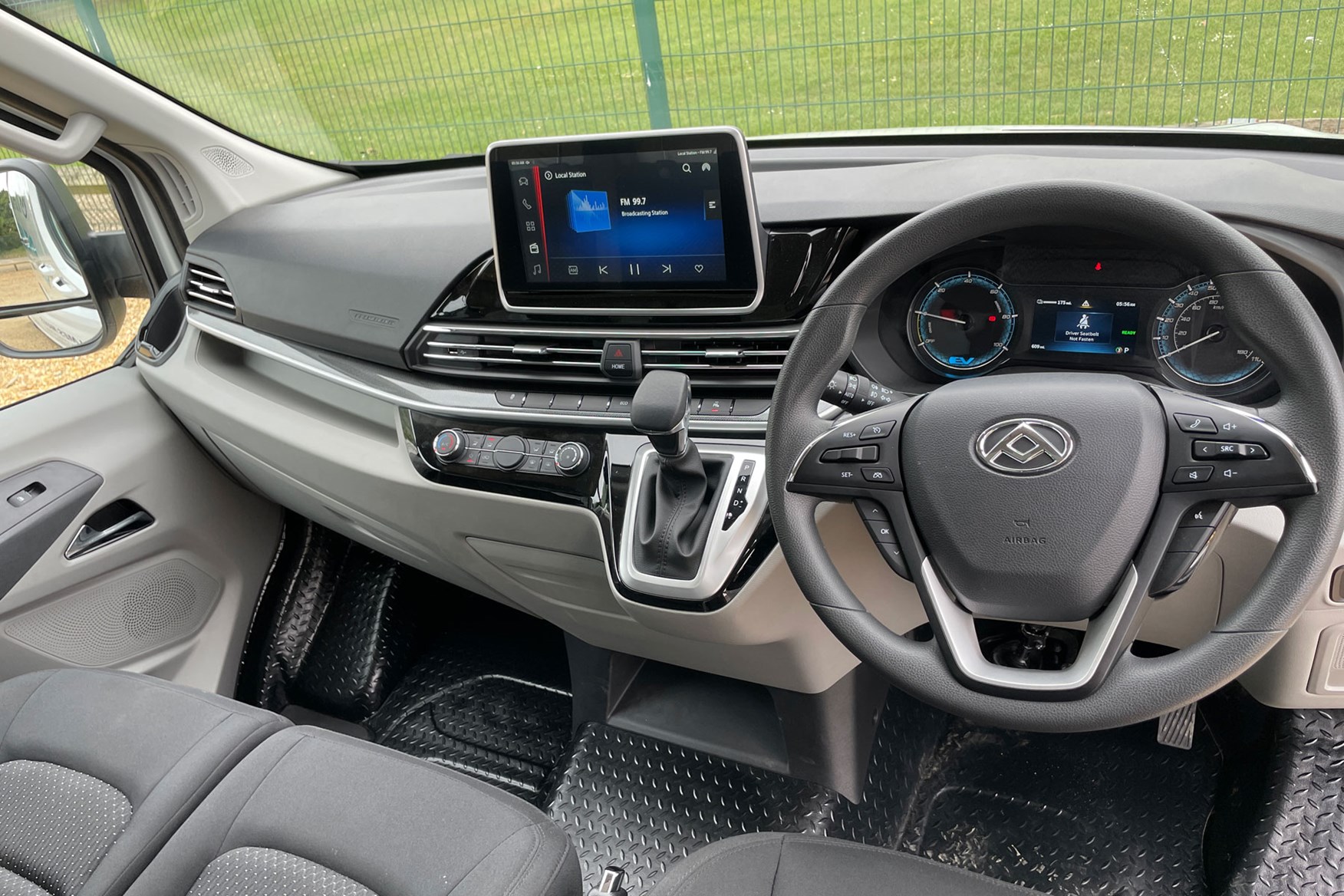
Instead, it majors on vertical lines, with only a small intrusion into the middle-seat passenger’s legroom to accommodate the gear lever. There is even a small cutout right at floor level to give the middle passenger a little more legroom. It doesn’t mean you’ll be stretching out in total comfort but it does add a welcome touch more space.
One area that tips into the realm of utilitarian is the floor – it is covered with a smooth, hard-wearing lino-style material, which should be simple to sluice out should you bring half the building site in with you. The raised bumps covering it help to add a little grip but it can still be a bit slippery, particularly if you are in shoes without lots of tread of their own.
Space in short supply
The car-like styling of the dash means that the Maxus lacks in storage, as there is not much in the way of covered cubby holes or door pockets. There is a glove box and overhead storage, but there are not loads of slots to easily chuck something when you jump in between deliveries.
There isn’t masses of room in the footwell either – the wheelarches encroach to the right of your right foot so it could feel a little cramped at times, even with just the two pedals to worry about.
The infotainment screen is large and clear and has lots of the features you would want, with Apple Carplay and Android Auto a standard offering, which is great. There are a couple of frustrating oddities though – for such a new van it is strange that there is just the one old-style USB port, and there is no really clear place to slot a phone that will keep it safe from sliding around. Secondly, and odder still, is the lack of DAB digital radio. You’ll need that USB cable to ensure you listen to anything behind FM and AM while on the move.
- Not as cheap as rivals
- Five-year warranty
- 24-month service intervals
The initial purchase price of any large van looks expensive compared to an entry-level diesel version, but there are plenty of other ways to make up the difference.
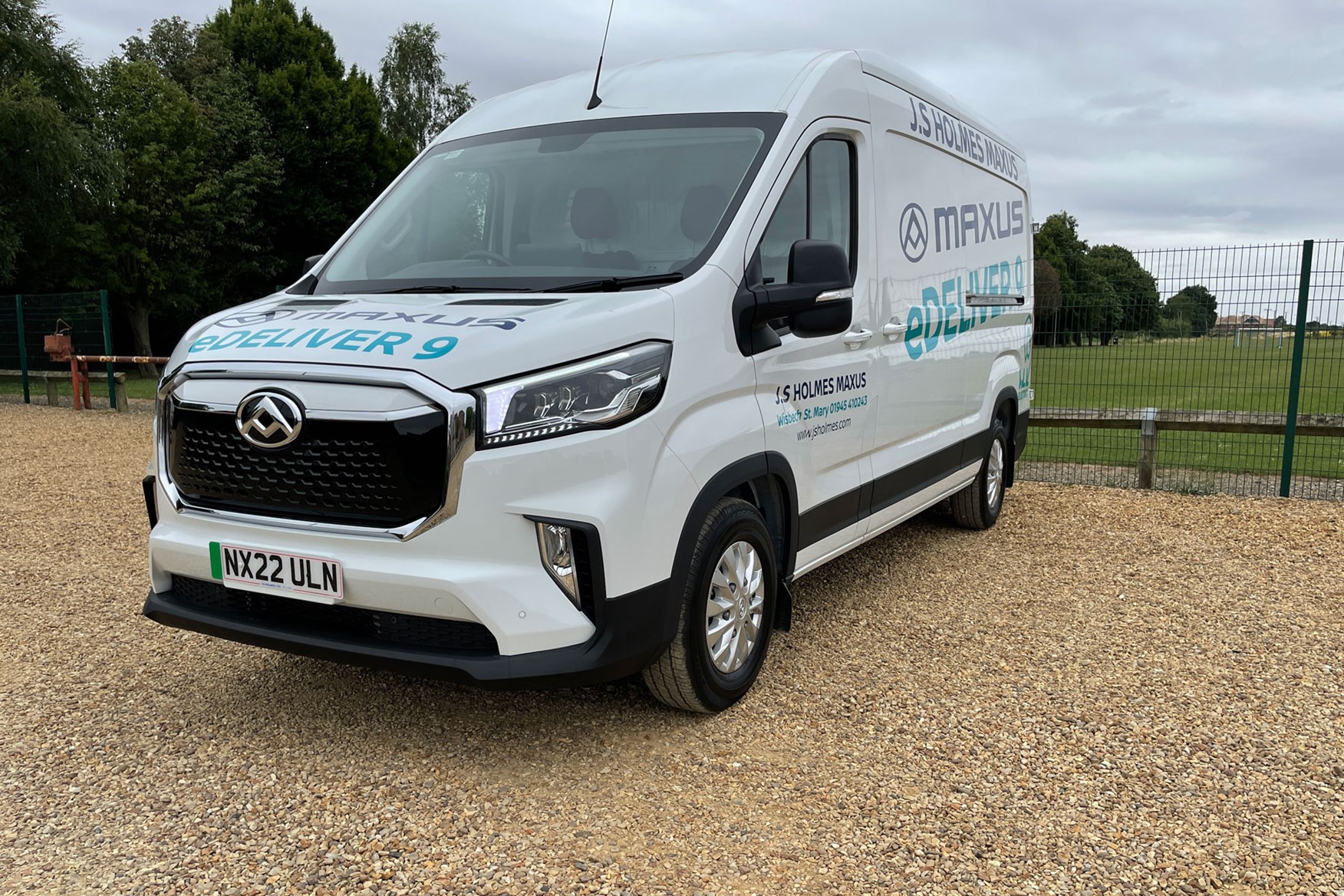
The low tax rates, decent range and lower service, maintenance and repair costs should all chip in to make up the shortfall.
How much does the Maxus eDeliver 9 cost to buy?
The Maxus eDeliver 9’s price is quite punchy, at £63,000 not including VAT. However, this also doesn’t factor in the plug-in van grant, which will take a chunk off. Maxus has also invested a lot of money in the electric market in the UK, so there might well be future incentives once the money has run out.
That £63,000 starting price is for the smallest battery – if you want the big 99.55kWh version then prices start at £71,000.
Maxus eDeliver 9 range and charging time
The range for the eDeliver 9 starts at a pretty competitive 112 miles for the 51.5kWh battery – this is less than many of the big rivals in the class, and would be a problem if this was the only version, but it is joined by the 72kWh version with a 146-mile range. The range-topping 88.55kWh version’s 185-miles is second only to the Ford E-Transit’s.
Maxus eDeliver 9 servicing
The servicing intervals for the Maxus eDeliver 9 are a decent 24 months or 18,000 miles apart, whichever comes first. This is decent but not as far apart as some rivals – the E-Ducato lets you do 30,000 miles while the Ford E-Transit allows unlimited mileage, although you do have to go in every 12 months.
Maxus eDeliver 9 warranty
The majority of the eDeliver 9 has a warranty that lasts a handy five years but only covers you for 60,000 miles. The battery is covered for eight years and 100,000 miles though.
Maxus eDeliver 9 standard equipment
There is only one trim offered on the eDeliver 9, and the kit it comes with is thankfully generous, even if the omission of DAB digital radio is a curious one. Below are some of the highlights:
- 10-inch touchscreen with Apple Carplay and Android Auto
- 16-inch alloy wheels
- Air conditioning
- Full steel bulkhead
- Cruise control
- Heated door mirrors
- LED headlights
- Keyless entry and stop / start
- Front and rear parking sensors
- Reversing camera
Maxus’ relatively recent arrival in the UK means there isn’t the same historical data on how the vehicles have performed. That said, the eDeliver 9 is a fairly new model anyway. EVs have fewer moving parts than diesels, so should suffer fewer faults.
- Excellent amount of airbags
- Some technical equipment
- Some notable omissions though
There is no ability to add extra safety kit onto the eDeliver 9 but the basic equipment is better than on many other vans.
It comes with an automatic emergency braking system, lane change assist and lane departure warning, blind spot monitoring and an emergency eCall system.
There are a good number of airbags for a van too, with one for the driver and passenger and a front double curtain ‘bag.
Which MAXUS e Deliver 9 is best for me?
This is simple – it’s just a case of choosing which battery you want and which size you need. The smaller model with the medium battery has the best combination of payload and range, but it is easy to adjust either way depending on which is most important to your needs without compromising too much.
The smallest battery might not have enough range for everyone, but it has enough that plenty of businesses will be able to get through a day without topping up.








